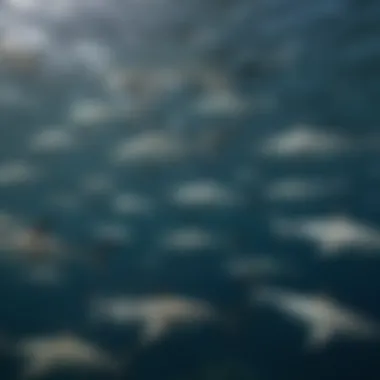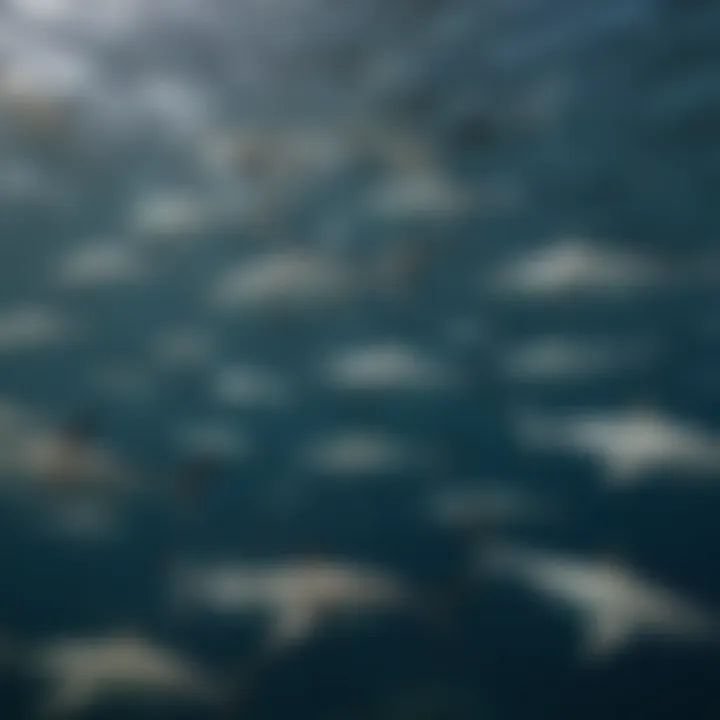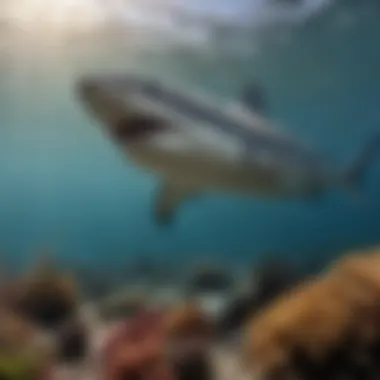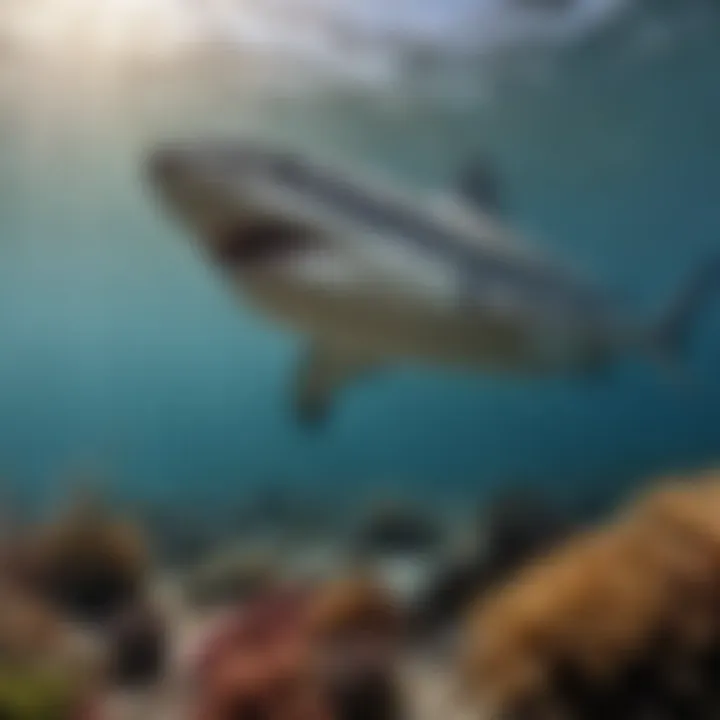True Facts About Sharks: Understanding Their Role in Nature


Intro
Sharks are some of the ocean's most fascinating inhabitants. Despite their often fearsome reputation, they play a pivotal role in marine ecosystems. With over 500 species, from the diminutive dwarf lanternshark to the colossal whale shark, the diversity within the shark family is staggering. Common misconceptions shroud these creatures, leading to an array of myths that can overshadow their true nature.
This article aims to unravel the complex world of sharks by shedding light upon essential facts about their biology, ecology, and interaction with humans. Addressing seven key themes will aid in demystifying these apex predators and illustrating their importance in maintaining the delicate balance of marine life.
Through a keen exploration of their evolutionary history, behavior patterns, and conservation efforts, the hope is to elevate awareness among enthusiasts and everyday people alike. As the tide of advocacy for these misunderstood beings rises, informed discourse becomes imperative to uphold their legacy in our oceans.
So, buckle up as we embark on this enlightening journey into the world of sharks.
Prelims to Sharks
The exploration of sharks is more than just a dive into the realm of marine life; it opens a portal to understanding the intricate web of interactions within our oceans. Sharks have long captivated our imagination, not just for their formidable presence as apex predators but for their ecological importance. By understanding sharks, we gain insight into the health of marine ecosystems and the evolutionary history that shapes life in our oceans.
This section aims to lay the groundwork for the detailed journey ahead. Learning about sharks is essential not just for conservation efforts but also for educating the public on their role within marine ecosystems. We will touch on their fascinating history and their unique biological features, all of which contribute significantly to their status in the natural world.
Historical Context of Sharks
Sharks belong to a lineage that stretches back more than 400 million years, predating the dinosaurs. Their ancient lineage illustrates a remarkable ability to adapt and survive through various ecological shifts and mass extinctions. Initially, these creatures were small and unremarkable, but as time went on, they evolved diverse forms and sizes.
Archaeological records reveal spikes in shark diversity during certain periods, aligning with major changes in ocean conditions. These changes saw sharks develop into large pelagic hunters, showcasing their impressive adaptability. Fossilized remains like the Megalodon tell us of a time when these giants roamed the seas, reminding us of the ocean’s ancient diversity.
Importance in Marine Biology
Understanding sharks is crucial for marine biology for several reasons. First and foremost, sharks are top predators; they play a key role in maintaining the balance of marine ecosystems. For instance, studies show that the removal of sharks from coral reef systems can lead to overpopulation of certain species which then devastate the reefs.
Moreover, they possess various unique adaptations that contribute to our overall understanding of evolutionary biology. The study of sharks can also aid in biomedical research, as their immune systems are of significant interest. Their resilience to diseases helps scientists seek treatments for human conditions.
In summary, sharks are not mere subjects of curiosity; they are essential to the health of our oceans and offer us valuable insights into biology and ecology. By comprehensively studying these creatures, we ensure that we can protect both them and the environments they inhabit.
Anatomical Features
When diving into the intricate reality of sharks, one can’t overlook their anatomical features. These features are not just for looks; they play crucial roles in how sharks navigate their environment and hunt for food. By understanding the anatomy of these ancient creatures, we can appreciate their efficient adaptations that have allowed them to thrive for millions of years.
Skeletal Structure
Cartilaginous Composition
Sharks are unique in that they possess a cartilaginous composition instead of a bony skeleton. This means their bodies are made predominantly of cartilage, the same material that gives flexibility to human noses and ears. Such a structure makes them lighter and more buoyant, allowing them to move swiftly through water.
This lightweight body contributes to their speed and maneuverability, making sharks some of the most adept hunters in the ocean. Cartilage also allows sharks to absorb shocks more efficiently than bones would, which can be quite handy when they engage in rapid movements while hunting.
Additionally, the resilience of cartilage provides several benefits: it reduces the overall energy expenditure while swimming. However, this composition does have disadvantages. For example, cartilage lacks the density that bones provide, meaning sharks may have to work a bit harder to avoid sinking. Nonetheless, the benefits largely outweigh these drawbacks, positioning sharks as incredibly successful predators.
Comparison with Bony Fish
In contrast with bony fish, sharks offer a different way to approach life underwater. While bony fish possess a rigid skeleton with bones that may serve as protective structures, sharks benefit from flexible cartilage. This contrast highlights a significant evolutionary divergence between the two groups.
Bony fish often have denser bodies due to bones, impacting their buoyancy control. Sharks, however, rely on oil-filled livers as a buoyancy aid, which can be an advantage. This allows sharks to hover effortlessly without flapping their fins constantly, making energy conservation critical during long hunts.
The unique feature of a shark's anatomical structure serves as a splendid illustration of adaptability. Bony fish must utilize swim bladders for buoyancy regulation, which can limit their maneuverability. Sharks, with their anatomical design, evade such limitations, thriving in complex and diverse marine environments.
Sensory Systems
Sharks have some of the most sophisticated sensory systems in the animal kingdom, which is another aspect that differentiates them from many other fish. Their ability to detect minute changes in their environment equips them for successful hunting and navigation. Understanding these features provides insight into their predatory prowess.
Electroreception
The capability of electroreception is one of the most impressive features of sharks. They possess specialized organs known as electroreceptors that enable them to sense the electrical fields generated by other living creatures. This sensory adaptation allows sharks to detect prey even when it is hidden beneath the sand or in murky waters.
The key characteristic of electroreception is its sensitivity; sharks can detect even the weakest electrical signals. This adaptation plays a significant role in their hunting strategies, particularly in environments where visibility is low. It is an efficient method of prey detection that can mean the difference between a successful hunt and going hungry.
However, while this capability is beneficial, it may also have limitations in crowded ecosystems where many animals emit electrical signals, possibly creating confusion for the predator. Still, the advantages of electroreception greatly contribute to the apex predator status of sharks.
Acute Sense of Smell
Sharks are notorious for their acute sense of smell, which allows them to detect blood and other compounds in the water from miles away. This extraordinary ability stem from having a highly developed olfactory system. The key characteristic of this sensitivity is its range and specificity; they can identify particular substances in extremely diluted forms.
This sense of smell not only aids in locating prey but also helps sharks sense danger or track potential mates. The unique feature contributing to this acute ability involves specialized nostrils that are separate from the mouth, enabling them to filter water efficiently.
However, it’s essential to recognize that while this adaptation is incredibly beneficial, it may attract human fears about sharks because of their predatory reputation. This sense is sometimes exaggerated in media portrayals, reinforcing misconceptions about the species.
Reproductive Strategies
Shark reproduction is not a straightforward process and varies significantly across species, making it a fascinating area of study. Understanding these reproductive strategies provides critical insights into the overall health and sustainability of shark populations.
Live Birth vs. Egg Laying
Sharks can be classified broadly based on live birth versus egg laying. Some species, like the great white shark, give birth to live young, a method known as viviparity. Meanwhile, others lay eggs, a process known as oviparity.
The key characteristic of live-bearing sharks is the level of parental investment involved. Young fish are born fully developed and ready to fend for themselves. This might provide a survival advantage in competitive environments, as survival rates can be higher among newborns that can evade immediate predation.


On the other hand, egg-laying species, such as the bamboo shark, produce a large number of eggs at one time, which is a strategy to increase the chances of at least some surviving to adulthood. While the eggs are more vulnerable to predation, they are also less energetically costly to produce compared to maintaining live young through gestation. Each strategy presents its own set of advantages and potential drawbacks.
Parental Care Variations
In addition to their reproductive methods, parental care variations among shark species can provide insights into their social structures. While many sharks abandon their eggs or pups, some species exhibit varying levels of care. Certain sharks stay with their offspring for a longer period, offering protection and guidance.
The key characteristic of such parental care is to ensure a greater chance of survival for young sharks. This type of care can evolve adaptations that foster strong responses to predation threats, increasing the offspring's chances of survival when they are released into the wild.
However, keeping the young close can also lead to resource competition between the parent and offspring, which can be a disadvantage, especially in resource-scarce environments. This delicate balance shows a fascinating aspect of shark behavior that emphasizes the intricacies of their ecological roles.
"Sharks, despite being apex predators, unveil the complexities of marine ecosystems, acting as both hunters and nurturers."
Through these anatomical features, sharks exhibit unique adaptations that enable them to persist and flourish in the marine environments they occupy, highlighting their role in oceanic health and biodiversity.
Diversity of Shark Species
The world of sharks is far from monolithic; in fact, the vast diversity of shark species is one of the paramount reasons for their enduring intrigue. Comprised of over 500 recognized species, sharks inhabit various ecological niches, each equipped with specialized adaptations that set them apart. From the colossal whale shark to the diminutive dwarf lanternshark, this variety not only showcases the adaptability of sharks but also reveals their importance in maintaining ecological balance.
The diversity in size, shape, and behavior among shark species is not just fascinating—it also plays a crucial role in marine ecosystems. By exploring this diversity, we can better appreciate the intricate web of life in our oceans and understand the vital roles sharks perform. They are not merely apex predators but also key players in controlling prey populations and ensuring the health of marine environments.
Known Species Variety
Large Pelagic Species
Large pelagic species, such as the great white shark and the tiger shark, make for a captivating exploration into the world of sharks. These species roam the open oceans and can reach impressive sizes, with some weighing several tons. One of their most striking behaviors is their migratory patterns, which often span thousands of miles—this adaptability highlights their role as apex predators in varying marine ecosystems.
A significant characteristic of these giants is their great size, which not only helps them dominate their hunting grounds but also places them in a position where they can influence fish populations across great distances. These sharks are beneficial to the article as they exemplify the power dynamics in marine food webs.
An interesting feature of large pelagic species is their electroreception capability, allowing them to detect electrical fields generated by other organisms. This adaptation gives them an advantage in locating prey even in murky waters. However, their size also makes them targets for human activities, such as fishing and hunting, which pose substantial risks to their populations.
Small Coastal Species
On the other end of the spectrum, small coastal species like the dogfish and bamboo shark may not command the same awe as their larger counterparts, but they are equally vital in maintaining marine biodiversity. These species thrive in shallower waters and play a significant role in their local ecosystems—some are even known to exhibit unique reproductive strategies like ovoviviparity.
The key characteristic here is their adaptability to coastal environments. This adaptability allows them to navigate through various habitats, from coral reefs to kelp forests. Their presence is beneficial in understanding the dynamics of coastal ecosystems, showcasing how smaller sharks contribute to overall marine health.
Small coastal species have a unique ability to rapidly reproduce, making them crucial for maintaining population levels amid ecological changes. Yet, their proximity to human activity means they are also susceptible to threats from fishing practices and habitat degradation. With their delicate position in coastal environments, they serve as indicators of ecological changes, offering insight into the health of marine systems.
Unique Adaptations Across Species
Filter Feeders
Among the fascinating adaptations observed in shark species is filter feeding, primarily seen in the whale shark and basking shark. These gentle giants might seem out of place in a discussion about apex predators; however, their size allows them to filter enormous quantities of water for tiny prey such as plankton. This unique feeding mechanism showcases how diverse the diets of sharks can be.
One of the prime characteristics of filter feeders is their capability to process nutrient-rich waters. They play a significant role in the marine ecosystem by helping to maintain plankton populations and, in turn, influence the broader food web. Their existence is essential in amplifying the connection between different levels of the ecosystem, which contributes to the resilience of marine life.
The ability to efficiently cycle nutrients via filter feeding proves advantageous, especially as ocean conditions fluctuate. However, their size can sometimes lead to misunderstandings by the public, who may still associate sharks primarily with aggression and predation, not recognizing the value these species bring to marine ecosystems.
Ambush Predators
Ambush predators, like the great hammerhead and the thresher shark, highlight another fascinating aspect of shark behavior. They rely heavily on stealth and surprise, employing strategies that involve hiding and waiting for the perfect moment to strike their unsuspecting prey. This hunting tactic showcases the cunning side of these creatures, telling another layer of their story.
The critical feature of these sharks is their unique hunting techniques, utilizing their physical adaptations, like elongated pectoral fins and specialized body shapes, to navigate through their environments effectively. Understanding how these predators have evolved their hunting styles offers valuable insights into their ecological roles and the mechanics of marine food webs.
While ambush strategies may seem less noble than the outright ferocity of more aggressive hunting styles, they nonetheless contribute to the balance of life in marine environments. Notably, their reliance on ambush tactics makes them vulnerable to habitat changes since they often depend on specific environments for hunting. Drawing attention to these nuanced hunting strategies provides a comprehensive view of the significance of diversity in shark behavior.
Evolutionary Journey
The journey of sharks through time stretches back over 400 million years, showcasing their remarkable adaptability and survival skills. This section dives into the evolutionary route that has led to the diverse array of species we see today. By understanding their origins and the adaptive strategies they have employed, we can get a clearer picture of how these creatures have become the apex predators of the marine world. This exploration isn't just about the past; it offers insights into their current behaviors and ecological roles.
Origin of Sharks
Ancient Lineages
The ancient lineages of sharks reveal much about their fundamental biology and ecological roles. Sharks are believed to descend from a lineage that dates back to the Devonian period, sometimes dubbed the "Age of Fishes." One of the key characteristics of these ancient sharks, such as Dunkleosteus, is their fierce predation — they were among the first large marine predators. This lineage highlights the evolutionary innovations that have allowed sharks to thrive for eons, and it's a compelling choice for this article because it underscores their adaptability.
A unique feature of these ancient lineages is their skeletal structure made of cartilage rather than bone. This provides flexibility and buoyancy, traits that are advantageous in diverse marine environments. However, while advantageous for mobility, this characteristic can also make these early species more vulnerable to certain ecological changes, as they lack a hard, mineralized skeleton that can withstand varying habitats over time.
Fossil Records
Fossil records are key pillars of shark research, offering a timeline that chronicles evolution and adaptation. One significant aspect is that many shark species, like the iconic Megadolon, left behind robust evidence of their existence through teeth, which tend to fossilize well. The key characteristic of fossil records is their ability to provide direct evidence of historical diversity and distribution.
These records benefit our understanding of evolutionary pathways, as they demonstrate how sharks adapted to various environmental pressures, from changes in climate to the rise and fall of different marine ecosystems. However, reliance on fossil records also comes with its downsides: gaps in the timeline and incomplete specimens mean that some evolutionary transitions remain a puzzle. Despite this, fossil records are invaluable for painting a fuller picture of the historical context of sharks and their remarkable endurance.
Adaptive Radiation
Survival Strategies
Survival strategies highlight the various tactics sharks have developed to thrive in dynamic marine environments. Almost like a Swiss Army knife, different species have developed specific adaptations, whether it be the speed of the great white or the ambush tactics of the tiger shark. Such strategies speak volumes about their ability to seize opportunities and navigate challenges in the wild, which makes them particularly interesting for this article.
One unique feature of these survival strategies is their behavioral plasticity. Some sharks can alter their hunting styles based on the type of prey available. While beneficial for exploring ecological niches, this flexibility can also be a double-edged sword, as it may expose them to additional risks like over-reliance on a single food source.


Environmental Changes
Environmental changes play a crucial role in shaping the path of evolutionary development in sharks. Their habitats have fluctuated significantly over time due to events like ice ages or tectonic shifts. This section's key characteristic is the examination of how these changes prompted significant adaptations for survival.
An interesting feature of this paradigm is the ability of sharks to respond to dramatic shifts, such as warming ocean temperatures. Sharks can adjust their migratory patterns, breeding strategies, and even their food sources. While this adaptability allows for continued survival, it often comes with compromises, including vulnerability to human-induced changes like pollution and overfishing. 💡 Understanding these evolutionary trajectories invites us to reflect on the resilience and fragility of sharks in the face of environmental stressors. Through their adaptive capacity, sharks illuminate the intricate dance between nature's forces and the species that navigate its currents.
Behavioral Ecology
The behavioral ecology of sharks is a fascinating avenue of study, highlighting how these apex predators interact with their environment and each other. It presents essential insights into the social structures, hunting techniques, and overall strategies that sharks employ to survive in their aquatic habitat. Understanding these behaviors not only sheds light on their roles in the marine ecosystem but also enhances our comprehension of their methods of adaptation and survival mechanisms. This section aims to unpack the intricacies of shark behavior, which is pivotal for both conservation efforts and for dispelling prevalent myths regarding these magnificent creatures.
Hunting Techniques
Pack Hunting
Pack hunting is a striking aspect of shark behavior that underscores their adaptability and collective intelligence. This technique is employed by certain species, like the great white and hammerhead sharks, which gather in groups to increase their hunting efficacy. One significant characteristic of pack hunting is its ability to sting the competition out of prey, thus allowing sharks to tackle larger food items or fatter fish that a solitary predator might find challenging.
By coordinating their movements, sharks can herd schools of fish into tighter groups, making it easier to attack. This strategic collaboration not only showcases their sophisticated social interactions but also highlights a critical advantage in ensuring successful foraging. However, one could argue that pack hunting does present its own set of complications; it requires a complex hierarchy and communication, which can be harder to establish in less social species.
Solitary Tactics
Contrasting with the dynamics of pack hunting, solitary tactics are equally essential to consider. Many shark species, such as the tiger shark, are known for their more independent hunting methods. These sharks rely on their astute senses and keen instincts to seek out lone prey, often utilizing stealth and surprise in their approach. A key characteristic of solitary hunting is the element of surprise; a stealthy approach can often lead to a more successful catch without the risk of competition.
The unique feature of solitary tactics lies in their flexibility; sharks can hunt at their own pace and adapt their strategy based on the environment without needing to coordinate with a group. However, this independent strategy can have disadvantages, as it may limit their prey options to smaller or less mobile animals.
Social Structures
Dominance Hierarchies
Shark social structures are complex, with dominance hierarchies playing a pivotal role. These hierarchies determine access to resources, mating rights, and overall social interactions among different shark species. A notable aspect of dominance hierarchies in sharks is their ability to influence group dynamics and hunting strategies. Typically, larger individuals hold higher status, which affects their interactions with others. This structure can create rivalries or alliances that ultimately influence their behavior. Though it can foster competition, it also protects the weaker sharks in the population, who may benefit from social interaction.
Territorial Behavior
Sharks are also known for exhibiting territorial behavior, significantly impacting their ecology. Some species establish specific areas they patrol and defend against others. The core characteristic of this behavior is the definite space that sharks claim, which is crucial for breeding and hunting. Territory allows them to maintain a reliable source of food and ensures their survival amidst competition. However, territorial disputes can arise, leading to aggressive encounters between individuals.
Moreover, changes in habitat due to human activities or environmental shifts can challenge these territorial behaviors, ultimately impacting shark populations and their roles in the ecosystem.
Sharks and Humans
Understanding the relationship between sharks and humans brings forth essential insights into both conservation and perceptions surrounding these creatures. Sharks play a critical role in marine ecosystems, yet their interactions with humans often lead to misconceptions and conflict. This section delves into two main areas: conservation status, where we uncover the ongoing threats to shark populations, and the human perceptions shaped by media and cultural narratives. By spotlighting these aspects, we aim to clarify the significance of sharks in our oceans and the urgent need for informed conservation strategies.
Conservation Status
Threats from Overfishing
Overfishing poses a monumental threat to sharks globally, significantly endangering their populations. Not only are sharks targeted for their flesh, but also for their fins, which are integral to the controversial dish known as shark fin soup. This culinary tradition, though a delicacy in some cultures, drives a gruesome practice known as finning, where sharks are caught, their fins removed, and they are often tossed back into the sea.
This brutal fishing method contributes to a substantial decline in shark numbers, jeopardizing their role in the marine ecosystem. The key characteristic of overfishing is its unsustainable nature; as more sharks are removed from the ocean than can be replenished, the balance of marine communities shifts. The unique feature of this situation is the cascading effects it creates. For instance, as shark populations dwindle, prey species may overpopulate, leading to overgrazing of smaller fish populations. Ultimately, this disrupts the entire marine ecosystem, creating a snowball effect that can threaten various species.
Habitat Destruction
Habitat destruction, another critical factor affecting shark populations, stems largely from human activities such as coastal development, pollution, and climate change. Key shark habitats, including nurseries in shallow coastal waters, face pressures from construction and runoff that pollute and degrade their environments.
One significant downside of habitat destruction is the loss of breeding grounds essential for shark reproduction. The unique aspect of this crisis is that it not only limits the availability of safe habitats but also impacts the survival rates of juvenile sharks. As these young sharks grow, their ability to thrive and reach maturity directly impacts the future populations of various species. By examining both overfishing and habitat destruction, we highlight the specific dangers facing sharks today and the converse implications on marine biodiversity.
Human Perceptions and Misconceptions
Media Influence
The role of media in shaping human perceptions about sharks is profound. Through television shows, movies, and news coverage, sharks are often depicted as vicious killers, fostering a perception that can lead to widespread fear and misunderstanding. This key aspect of media influence is significant; it tends to overshadow the reality that sharks, like many creatures, are far more complex and vital to ecosystems than their portrayal suggests.
A unique feature of media representation is how it can distort public understanding. Instead of recognizing sharks as apex predators playing a crucial role in maintaining healthy marine ecosystems, they are often viewed as mindless threats to humans. This leads to negative consequences, such as the decline of shark populations and the failure to appreciate their ecological importance, which impacts conservation efforts.
Understanding Sharks as Predators
Understanding sharks as predators is key to appreciating their place in the marine food web. These creatures are not mindless hunters; they contribute significantly to ecological stability by influencing prey populations and maintaining biodiversity. This key characteristic of their predatory role emphasizes natural balance; without sharks, certain species can proliferate, leading to ecosystem imbalances.
A significant aspect of understanding sharks involves distinguishing facts from fears. By promoting a clearer picture of sharks' behaviors and roles, we can dispel myths that have long plagued public perception. The advantages of such understanding are multifaceted: it can enhance conservation efforts, inform policy decisions, and change how we interact with these majestic creatures.
"Sharks have existed for over 400 million years, and despite their biological significance, they remain one of the most misunderstood creatures in our oceans."
Contrary to popular belief, a deeper appreciation for sharks can ultimately help safeguard our oceans.
The Role of Sharks in Marine Ecosystems
Sharks play a pivotal role in maintaining the health and balance of marine ecosystems. As apex predators, they are at the top of the food chain, and their presence significantly influences the behavior and population dynamics of their prey.
Top Predators
Impact on Prey Populations
Sharks exert a critical influence on the populations of other marine species. By preying on weaker or sick individuals, they help maintain the health of fish stocks. This process, known as trophic cascades, ensures that prey populations do not explode beyond sustainable levels.


A key characteristic of this relationship is termed "regulation through predation." When sharks are present, prey species like smaller fish and rays may behave more cautiously and avoid overgrazing on vital habitats, such as coral reefs or seagrass beds. The resulting balanced approach helps to keep these environments thriving and diverse.
However, when shark populations decline due to overfishing, overall ecosystem health may suffer. Potentially, it can cause prey populations to rise uncontrollably, leading to overexploitation of vegetation and subsequent habitat degradation, which could spell disaster for entire communities.
Biodiversity Maintenance
Another essential aspect of sharks in marine ecosystems is their contribution to biodiversity maintenance. Their presence supports the web of life across different habitats.
Sharks tend to target the most abundant or successful species in the ecosystem, which in turn allows for a greater diversity of species to thrive. A well-known example is the great white shark, which preys on seals and keeps their populations regulated.
This key characteristic makes sharks not just predators but also facilitators of environmental health. Their removal can lead down a slippery slope of biodiversity loss. In some regions where shark numbers have dropped, researchers observe a decline in species variety, which becomes problematic because lesser diversity can make ecosystems more vulnerable to diseases, invasions of non-native species, and environmental changes.
Keystone Species
Ecosystem Health Indicators
Sharks are often seen as indicators of oceanic health due to their streamlined and interconnected existence within the food web. As keystone species, their conditions can reflect the overall state of their habitats. Monitoring shark populations can offer scientists clues about the impacts of climate change or humanity's influence on marine ecosystems.
A remarkable feature of sharks as ecosystem health indicators is their long lifespan. Many species, like the greenland shark, can live for hundreds of years, which provides a sizable window of observation regarding environmental changes. Healthy populations often hint at a more vibrant ecosystem, whereas declining numbers may signal underlying issues like pollution or habitat destruction.
These characteristics underscore the importance of sharks not just for their role as predators, but as sentinels of marine ecosystem health, urging the need for stronger conservation measures.
Balance within Marine Communities
The concept of balance within marine communities revolves around sharks maintaining stability among various marine species. By controlling prey populations, sharks ultimately allow for a variety of species to coexist peacefully. Their hunting practices encourage competition among smaller predators, which contributes to a dynamic and balanced community.
A surprising characteristic of this balance is its impact on lower trophic levels. For instance, when there are fewer sharks, you might find an overpopulation of certain fish that consume important algae, leading to algal blooms. This indicates that sharks don’t just regulate fish but also affect primary producers and the entire community structure.
However, this balance is delicate. An increase in fishing pressure on shark populations can disrupt this harmony, leading to unforeseen consequences in associated species and habitats. Without sharks, marine communities can devolve into chaos, demonstrating their invaluable role.
Overall, the role of sharks within marine ecosystems is multifaceted and deeply interconnected with the health of our oceans. Understanding and appreciating this role is vital as we move forward in addressing conservation challenges.
Current Research and Future Directions
Understanding sharks goes beyond what we see on the surface; it delves deep into their behaviors, biology, and ecological roles. Current research is pivotal in revealing insights that were previously unknown. This section discusses how cutting-edge technological innovations and global conservation efforts shape our understanding of these apex predators.
Research on sharks not only enhances our knowledge but also informs conservation strategies. Engaging in meaningful studies can lead to better management practices that ensure the survival of these species. With overfishing and habitat destruction threatening shark populations, investing in research is a pressing necessity.
Technological Advancements in Study
Tagging and Tracking
Tagging and tracking have become a cornerstone in shark research, enabling scientists to monitor their movements and behaviors. The specific aspect worth mentioning is the use of satellite tags that allow researchers to follow sharks over vast distances. This feature is vital for understanding migration patterns, breeding grounds, and habitat preferences, providing essential data that supports conservation efforts.
One of the key characteristics of tagging is its ability to gather real-time data. This makes it a favored approach in current research. The disadvantage, however, is that the technology can be expensive and requires long-term commitment to capture meaningful trends. Still, it offers invaluable advantages – like how it illuminates the complexities of shark ecology and their interaction with the environment.
Genomic Studies
Genomic studies represent another edge of modern research, utilizing DNA sequencing to unravel evolutionary history and genetic diversity in shark species. This specific aspect offers insights into population health, enabling scientists to identify critical genetic markers and adapt conservation strategies accordingly.
The most notable feature of genomic studies is the ability to examine the genetic impact of environmental changes and fishing pressures on shark populations. Such studies have become popular for demonstrating how resilient these creatures can be, as well as revealing vulnerabilities that could aid in preservation efforts. A possible downside lies in the complexity of data interpretation, which can sometimes misguide actions if not approached with caution.
Conservation Efforts Around the World
International Treaties
International treaties play a vital role in ensuring the protection of sharks across borders. These agreements aim to unify nations in their efforts to curb illegal fishing and aggressive overfishing practices. What makes these treaties particularly beneficial is their emphasis on collaborative management of marine resources, acknowledging that marine life does not adhere to human-imposed boundaries.
A unique feature of international treaties is their potential for governance of migratory species, including sharks. Their advantages are apparent in fostering global awareness and responsibility for marine conservation. However, challenges arise when countries fail to comply with regulations, raising concerns over enforcement and accountability.
Local Conservation Projects
Local conservation projects, while perhaps appearing less grand than international treaties, often yield significant, nuanced results for shark populations in specific regions. Efforts may include community education initiatives and habitat restoration programs that engage local inhabitants in shark conservation. These projects help bridge the gap between scientific research and public involvement, creating a more informed and proactive community.
The emphasis on localized efforts is beneficial because they address specific threats unique to particular areas. A great feature of local conservation projects is that they often tailor their strategies based on the community’s needs and available resources. That said, the limitations might include restricted funding and the challenge of scaling these projects to larger contexts.
In summary, the intersection of technological advancements and conservation efforts is shaping the future of shark research. It builds a foundation for a deeper understanding, which ultimately influences public policy and awareness around these essential marine creatures.
Closure
In wrapping up our exploration of sharks, it's crucial to underline their significance in our oceans and the misconceptions that cloud our understanding of these magnificent creatures. The information covered throughout this article exposés not just their biological intricacies but also their vital role in maintaining the health of marine ecosystems. By looking deeper into their lives, behaviors, and interactions with humans, we begin to recognize that sharks are not merely mindless predators. Instead, they are animals essential for ecological balance.
Summary of Key Insights
Sharks, often portrayed as ruthless killers in popular culture, contribute a great deal to the ocean's biodiversity. They control prey populations, which helps maintain a balanced environment. Various species exhibit unique adaptations, from filter feeding methods seen in the whale shark to the stealthy hunting tactics employed by the great white shark. Also, the impact of human activity—overfishing and habitat destruction—has led to significant conservation issues that cannot be overlooked. Through understanding these topics, individuals can better grasp the delicate equilibrium within marine habitats and the sharks' crucial role in sustaining it.
The Path Forward
Role of Public Awareness
The emphasis here is on understanding what sharks truly represent in our ecosystems. Public awareness campaigns are vital. They serve to enlighten the public about the truth behind sharks, moving away from fear-based narratives towards an appreciation of their ecological importance. This shift in perception acts as a catalyst for conservation initiatives. A key characteristic of public awareness is the ability to engage diverse audiences, highlighting the interconnectedness of marine life and the ecosystems’ health. While the challenge lies in debunking long-standing myths, the benefit is scalable understanding and protection of marine biodiversity.
Advocacy for Shark Conservation
Advocating for shark conservation goes hand-in-hand with raising public awareness. Engaging in grassroots movements and supporting legislation helps address the pressing threats faced by sharks. Highlighting the unique feature of advocacy is the power it wields to bring people together, from scientists to local communities, all focused on a common goal. While it might take time to see tangible results, the groundwork laid through community involvement and scientific support is invaluable. It’s a popular choice in the conservation narrative, as everybody can contribute, making it an effective strategy.
"In every drop of water, there is a story of life." - The essence of marine conservation starts with sharks.
Understanding these dynamics not only reinforces the need for unity in shark conservation efforts but emphasizes that every individual's effort counts. We can ensure a future where these apex predators thrive, securing the intricate web of life that our oceans represent.







